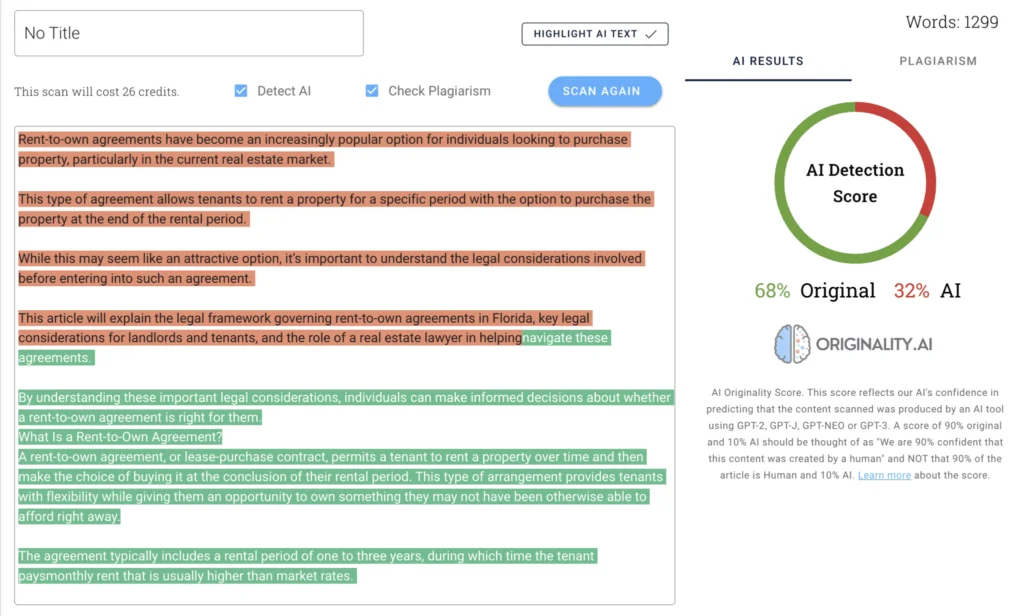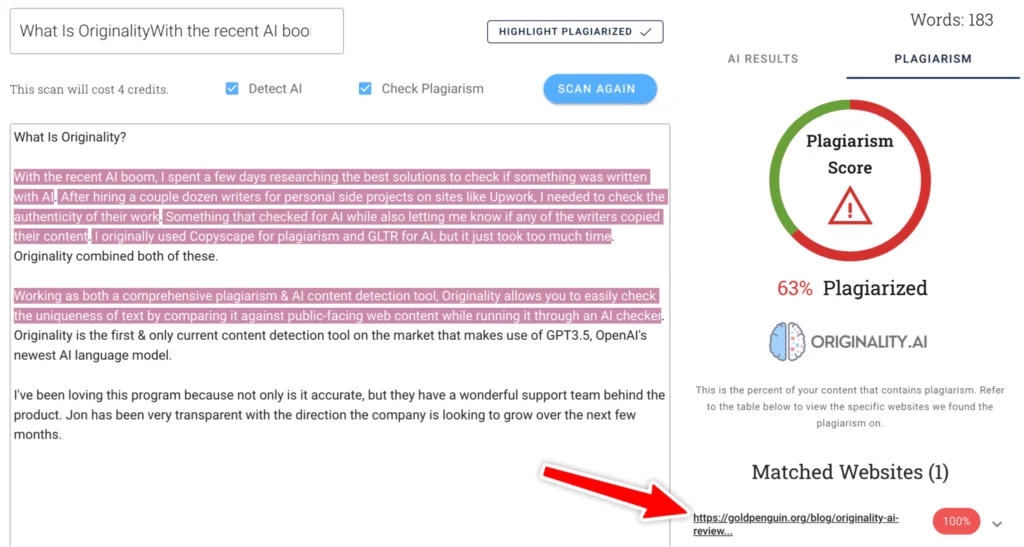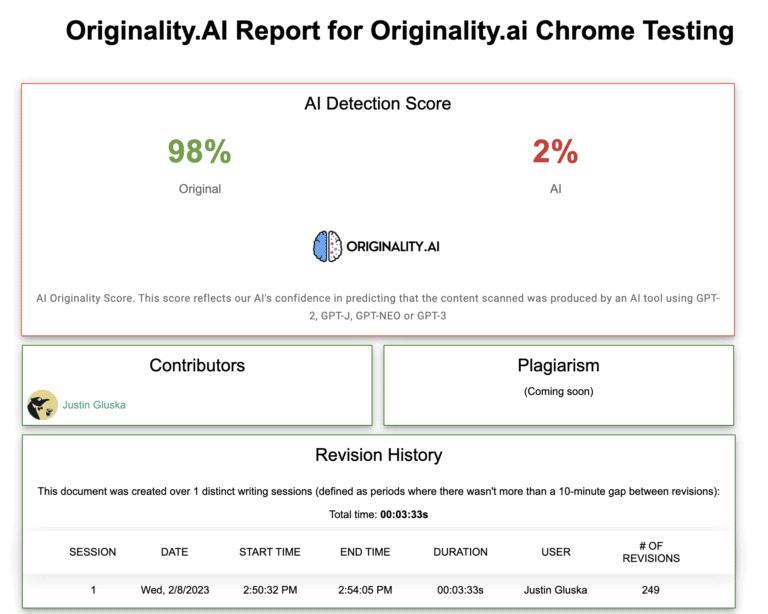

As a writer or publisher utilizing freelance contributors, ensuring content is original and not AI-generated can be challenging. Detector tools like Originality aim to identify AI-written or plagiarized text, but their accuracy remains imperfect.
I've used Originality since its launch. While impressive initially, I've come to view it as more of a general guideline than definitive assessment. Its AI detection should be considered with skepticism given the flaws of current technology. In this comprehensive Originality AI review I'll be covering the pros and cons, it's features, who should use it, and alternative options.
Originality offers automated AI and plagiarism detection to assess the originality of text-based content. Key features include:
Ideal users include publishers, agencies, writers, educators, and other parties dealing with large volumes of third-party content.
Originality AI Pros
Originality AI Cons
Pricing: 4/5
The pay-per-use credit system provides flexibility without forcing subscriptions. Reasonably priced at $0.01 per 100 words.
Accuracy: 3/5
Very accurate on less advanced AI like GPT-3 but falters more with ChatGPT. Still useful guidance but not definitive.
Features: 4/5
Impressive breadth of analysis capabilities from plagiarism to readability. Useful integrations like Google Docs extension.
Overall, I give Originality high marks for its innovative analysis capabilities, flexible pricing, and constant improvement. As AI detection technology continues advancing, Originality shows strong potential to grow as a leader in this emerging space.
Originality functions as both a plagiarism checker and AI detector. It compares text against publicly available web content to check uniqueness while running an AI analysis.
The tool was among the first public solutions for spotting AI content, preceding innovations like GPT-4. Originality offers an AI writing classifier and visualizer to potentially identify text from systems like ChatGPT.
Questionable Accuracy
Originality claims high accuracy rates in detecting content from specific AI systems:
But the rapid evolution of both AI writing and deception systems brings these benchmarks into question. Undetection technologies can increasingly mask AI-generated text.

When analyzing content, Originality provides a percentage score for the likelihood of AI. It also checks for plagiarized text by linking to potential source matches online.
You gain a general sense of originality, but take the AI probability with skepticism. The tool offers one data point, not definitive assessment, especially as evasion tactics advance.
The Limitations of AI Detection
While innovations like Originality move AI detection forward, fundamental challenges remain. Systems like GPT continue evolving rapidly with human-like nuance. And tools like Anthropic's Claude aim to avoid detection entirely through superior comprehension.
For now, view AI detectors as supplemental signals rather than perfect arbiters. Assess writing by its substantive quality rather than just software scores to determine value.
In my experience, Originality provides the most value for publishers, editors, educators, and other entities dealing with large volumes of third-party content. As an extra guard for quality and originality assurance, it serves several key use cases:
Students
Students can use Originality to validate their own writing if they utilized AI tools like ChatGPT during the creation process. This allows them to check their work. However, there are risks associated with teachers applying AI detection on student submissions.
Publishers & Editors
Publishers and editors frequently handle content written by a wide range of freelance contributors. Running submissions through Originality gives a quick, automated quality check to potentially catch issues before publication. This applies to both AI-generated and plagiarized text risks.
Journalists
Similar to publishers, journalists deal with content from many different sources when reporting on emerging stories. Originality allows them to gauge the originality of sources and accounts spreading information during time-sensitive news cycles.
HR & Recruiting Teams
For hiring processes involving written assignments, Originality can help screen applicants by detecting those leaning too heavily on AI writing assistance when asked to submit original thoughts.
SEO Agencies & Website Owners
Agencies producing content at scale can use Originality to confirm writers aren't just churning out AI filler content. Website owners may apply it when commissioning new page copy. Unique, quality copy remains critical for organic search visibility.
Website Flippers
When purchasing existing sites, running Originality reports on page content helps uncover any reliance on duplicated or AI-written material before investing significant time and capital into the acquisition.
For any role dealing in volume with third-party content, Originality serves as an efficient extra layer of protection against risks like plagiarism and AI-generated text.
Originality claims extremely high accuracy rates in identifying content from systems like GPT-3, GPT-3.5, and GPT-4.
Across 20 test articles, it flagged GPT-derived content with near 100% accuracy. But for ChatGPT, the lowest detection rate was just 90% despite more advanced capabilities.

This aligns with my experience that ChatGPT outputs can bypass detection more easily. As AI grows more nuanced, the limitations of detection technology become clearer.
It's important to emphasize AI identification operates on predictions rather than absolutes. Results should be considered as general guidance rather than definitive conclusions, especially for borderline cases.
Checking multiple pieces from a single author over time tends to yield clearer accuracy versus one-off analysis. I've found Originality sometimes falsely flags human writing as AI, known as false positives. But false negatives are less common - AI text is usually correctly identified.
Testing complex academic papers resulted in 90%+ assessed as original human writing. This makes sense given the depth and nuance. But simplistic ChatGPT content seems more easily flagged currently.

The rapid pace of advancement for both AI authoring and deception tools makes reliability an ongoing moving target however. As the arms race continues, even ChatGPT may eventually cross into reliably human-passing territory.
For now, view Originality's AI detection as a helpful supplementary signal when vetting unknown writers, but avoid over-reliance. Make reasoned qualitative judgements on substantive merit rather than just statistical scores. The technology remains imperfect and defeatable by the latest AI innovations.
While Originality doesn't necessarily reinvent AI detection, it succeeds in optimizing and centralizing the process. By consolidating plagiarism checks and advanced AI analysis into one platform, it streamlines quality assurance.
Line-by-Line AI Checking
A major capability is granular AI prediction scores for each line of text, highlighting the most suspicious sentences. This allows pinpointing potential issues versus just overall percentages.
According to case studies, Originality can accurately identify content from systems like GPT-3, GPT-3.5, and ChatGPT 99% of the time. GPT-3 scored best at 99.95%, with ChatGPT at 98.65%.
Seeing questionably AI lines flagged in red provides clear visual guidance:

Plagiarism Detection
Alongside AI checking, Originality scans text against publicly available online content to identify duplicate plagiarized passages. Suspicious matches are highlighted in pink:

This feature caught verbatim examples from my own review by cross-referencing content across the web. The crawling seems extensive and possibly even live updated.
Analysis Comparison
You can run multiple analyses to compare Originality results on the same piece of content over time. This helps track changes and optimization efforts:
Originality recently introduced a free readability analysis tool. It scans text and highlights syllables to showcase areas needing simplification based on grade level.
The Flesch-Kincaid scale provides an overall grade level score. For example, a score of 10th grade level indicates reasonably accessible writing to a broad audience.
This data helps refine complex content to be digestible by your target readership. The visual syllable highlighting aids revision.
The Originality Chrome extension enables one-click plagiarism and AI checks across any web page or document. Key features include:
For collaboratively authored pieces, the extension lets you easily identify if sections were simply copied in from an outside source or written by the assigned author.

This exonerates writers against false AI accusations by proving human authorship. It also builds confidence for publishers that articles are original before posting.

The Chrome extension provides multifaceted benefits:
Writers - Prove content was manually written, avoiding assumed AI authorship.
Agencies - Verify writers are submitting original work as required.
Publishers - Confirm articles are high-quality and plagiarism-free pre-publication.
For any workflow involving third-party writing, the extension inserts helpful safeguards and visibility without disrupting existing processes.
A powerful recent addition is the ability to perform complete AI audits across entire websites. This scans all pages on a domain to quantify originality.
I tested it out on our company blog and was impressed. It efficiently runs analysis on each post, listing the word count and predicted AI percentage. Pages are sorted from most to least original based on the scores.
This provides an invaluable macro view of potential AI risks and optimization opportunities across all site content in one report.
While currently focused on AI detection, plagiarism support would make this feature even more well-rounded. Running full plagiarism scans could uncover extensive duplication issues.
For my site's 142 pages, a website audit utilized around 600 credits costing $6. Given the depth of analysis, I found this very reasonably priced and well worth the insights gained.
The website audit equips you to thoroughly benchmark content originality at scale and track improvements over time. I don't foresee needing to rescan more than annually in most cases.
As content libraries grow larger, having an overarching view of AI and plagiarism risks becomes essential. This feature fills that need for in-depth assessments beyond just sampling posts.
Originality allows businesses and teams to create shared accounts with member access. This streamlines oversight for organizations like:
Rather than individual logins, you can add writers, editors, students, or other roles as members under a central account.
Benefits of consolidated team access include:
For managers, you gain visibility into content being produced across the organization in one place. This allows tracking work volume along with originality rates.
Team members also receive personalized dashboards demonstrating their individual usage and scan results.
Whether it's a quality assurance team checking writer output or a university monitoring academic integrity, shared accounts enable convenient oversight. Access and credits can be allocated based on needs.
For any multi-user use case dealing with third-party content, centralized administration through teams eases management while providing key insights. This enhances workflows and oversight without creating new siloes.
Rather than subscriptions, Originality utilizes a pay-as-you-go credit system costing $0.01 per 100 words scanned. You only pay when you need additional credits, without recurring fees or minimums.
Each analysis deducts credits based on length and options enabled:
No long-term commitment is required. Purchase credit bundles on-demand:
This flexible approach is ideal for intermittent or seasonal use cases. Teams can allocate project budgets towards scans without ongoing overhead.
The reasonable $0.01 per 100 words rate means analysis costs scale predictably based on content volumes. For context, scanning a 1,000 word article would deduct just 10 credits or $0.10 at base pricing.
While some competitors require expensive monthly subscriptions, Originality's pay-as-you-go model aligns costs closely to unique usage patterns and scenarios. One-off scans can be purchased without forcing recurring fees.
For organizations producing or handling varying content volumes monthly, the credit-based pricing provides welcomed flexibility and transparency.
As an emerging platform launched in 2022, Originality has room to grow its capabilities over time. Here are some tweaks that would enhance the offering:
UI/UX Refinement
The interface feels a bit dated and disjointed in places. Content scans aren't presented in the most intuitive format. Polish to the UI would elevate user experience.
Simplified Workflows
Upon initial use, the workflow takes some learning to operate smoothly. Improving intuitiveness through UI tweaks could help newcomers ramp up faster.
Multilingual Support
Currently Originality only supports English text analysis. Expanding to other major languages would widen the addressable market.
API Enhancements
Developers can integrate analysis via the API, but expanded capabilities could allow more customization.
Plagiarism Updates
Expanding the website audit to include full plagiarism scanning would provide more holistic insights.
Despite being relatively new, Originality already provides robust core functionality. The roadmap focuses on the right areas to refine user experience and detection capabilities even further.
Based on my frequent use over the past months, I would certainly recommend Originality to others. Its AI and plagiarism detection provides ongoing value as part of my content workflow.
I utilize the AI checks more heavily than plagiarism scans. But both have proven effective at flagging questionable content for further review.
Some key tips on getting the most from Originality:
For anyone producing or handling large volumes of third-party content, I believe Originality merits consideration. The affordable pay-as-you-go pricing makes it easy to test out.
Ideal users include publishers, agencies, educators, HR professionals, and individual writers concerned with creating and curating original content.
While still improving, Originality already offers immense value as part of well-rounded quality assurance workflows for assessing creative work product.
ZeroGPT
ZeroGPT offers similar AI text analysis to detect content generated by systems like GPT-3 and ChatGPT. It provides overall scores as well as highlights risky sentences. This product offers a free plan that is enough for the casual user.
Copyleaks
Copyleaks is primarily a plagiarism checker but also includes AI-written content detection. It compares text against web sources and in-house content databases.
Grammarly
Grammarly recently added an AI detector to its writing assistance capabilities. It provides an overall AI score with limited detail on how assessments are made.
ProWritingAid
ProWritingAid combines grammar checking and style editing with an AI tool to flag suspected AI-generated text. The accuracy is questionable but can provide a general sense.
In my extensive first-hand usage, Originality delivers immense value as part of well-rounded content quality assurance workflows. For anyone regularly handling content from outside sources, it merits strong consideration.
The line-by-line analysis provides clear, actionable insights into risky areas that warrant further examination. The pay-as-you-go pricing aligns costs transparently to usage without subscriptions.
While AI deception techniques continue advancing, limiting current detection accuracy, Originality still serves as a beneficial supplementary assessment based on prediction algorithms.
For optimal results, treat its outcomes as one helpful signal among many, not an absolute final say. Make reasoned qualitative judgements on writing as well. But the tool undoubtedly enhances early vigilance against plagiarized and AI-generated text risks.
As one of the first solutions focused specifically on AI content risks, Originality shows impressive capabilities with significant headroom to improve as technology evolves. For managing quality at scale, it delivers real value.
Yes, Originality's plagiarism checking will identify text that has been copied directly from other online sources and flagged as unoriginal.
Not currently, but their API allows developers to build custom integrations with other platforms.
Originality allows you to fully delete uploaded text after analysis. They also employ encryption and have completed security audits to ensure confidentiality.
Originality supports documents up to 10,000 words in length. Longer pieces can be split into multiple uploads.
Yes, you can get 50 credits by installing the Chrome extension to test Originality.AI’s detection capabilities. 1 credit can scan 100 words.
For a 1,000 word document, you can expect results within 10-20 seconds typically. Speed scales linearly based on length.
